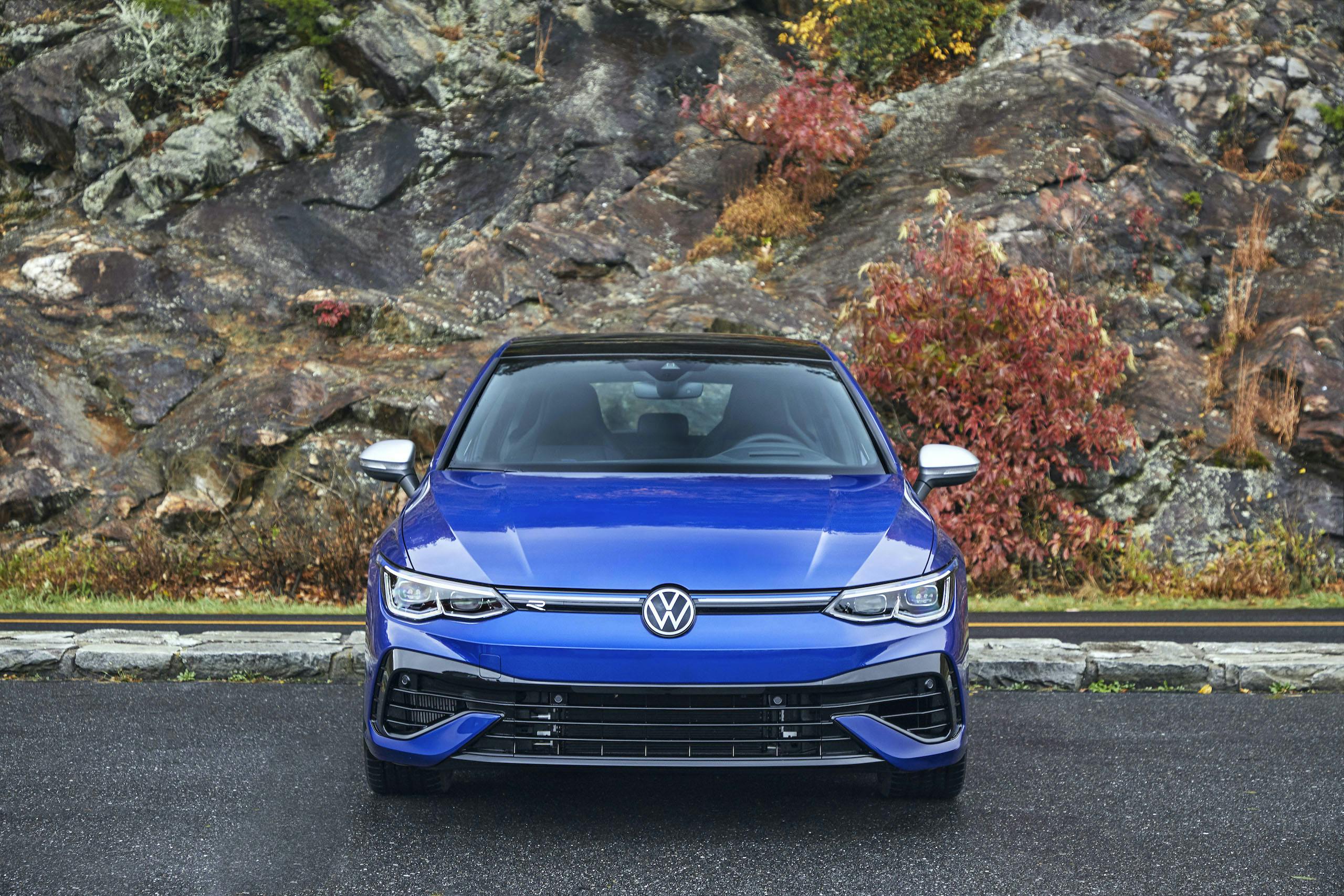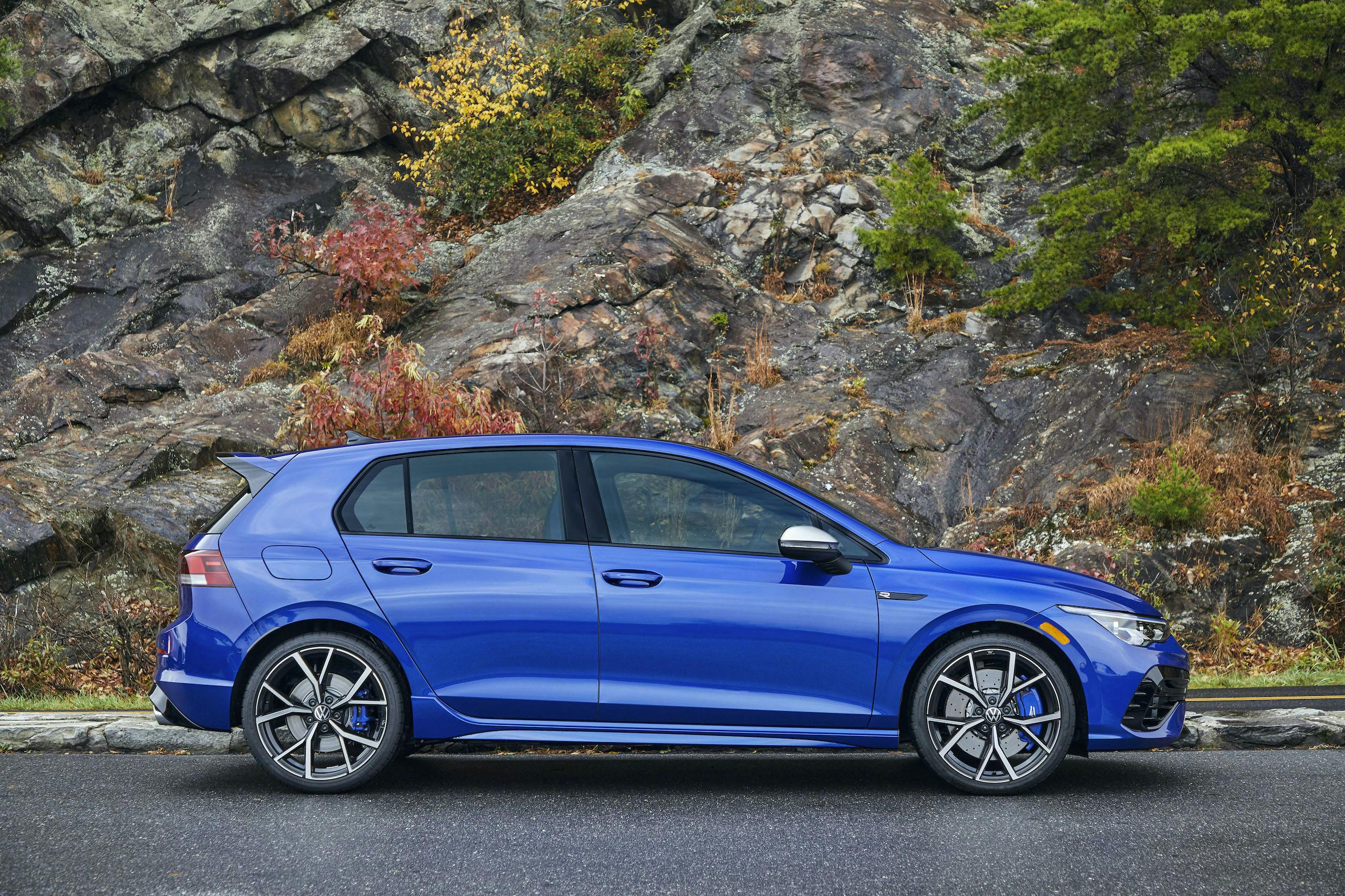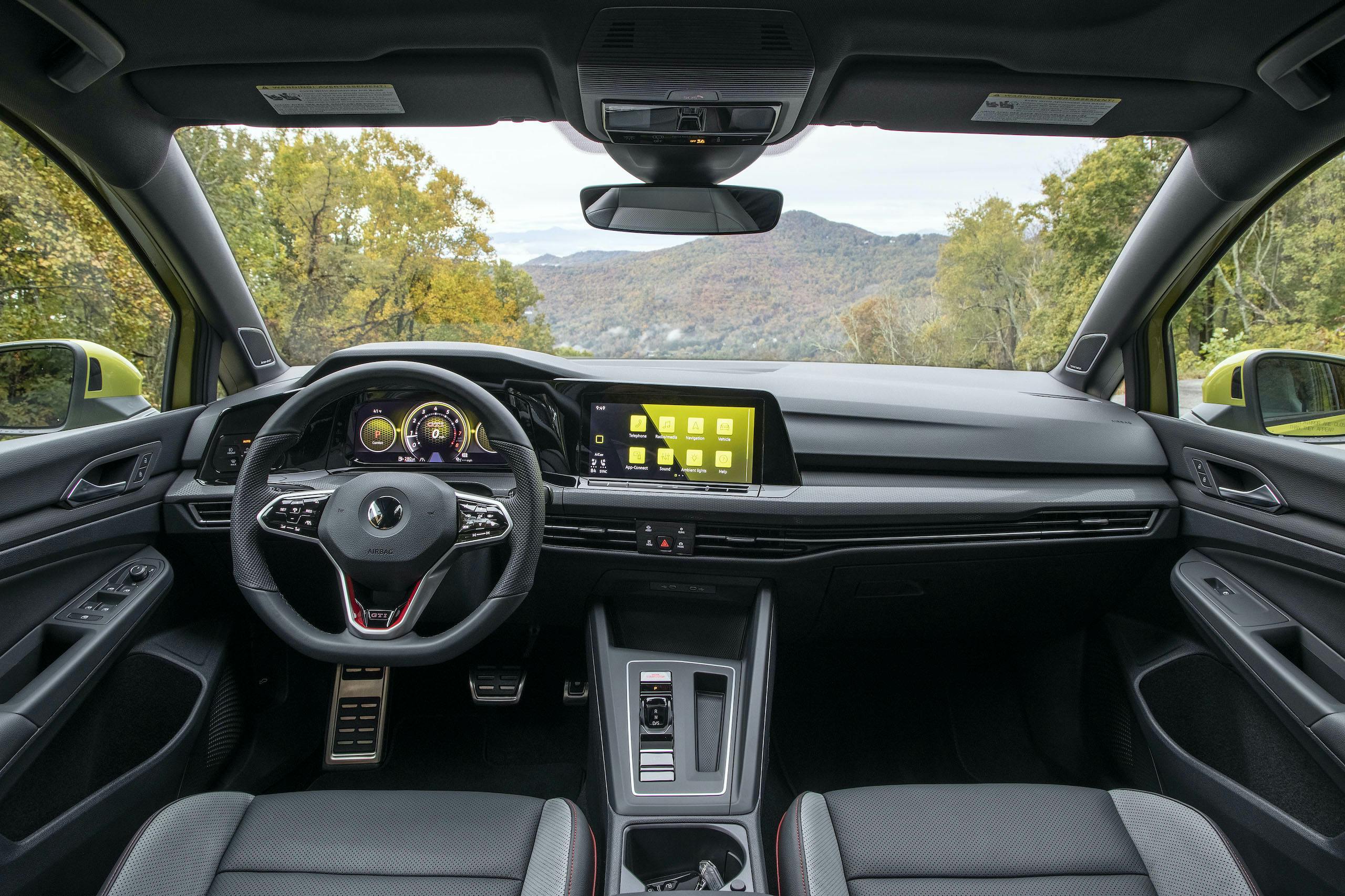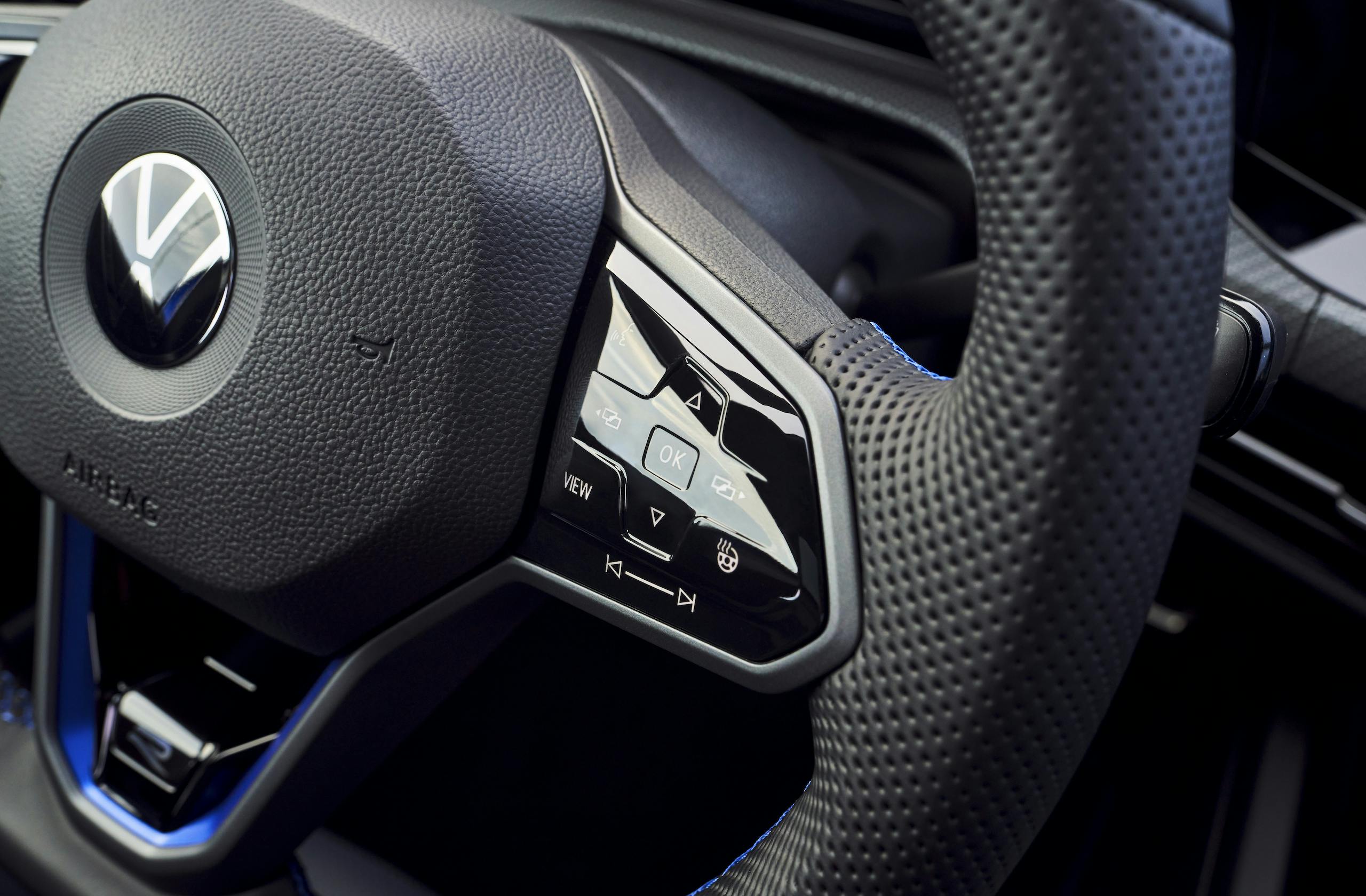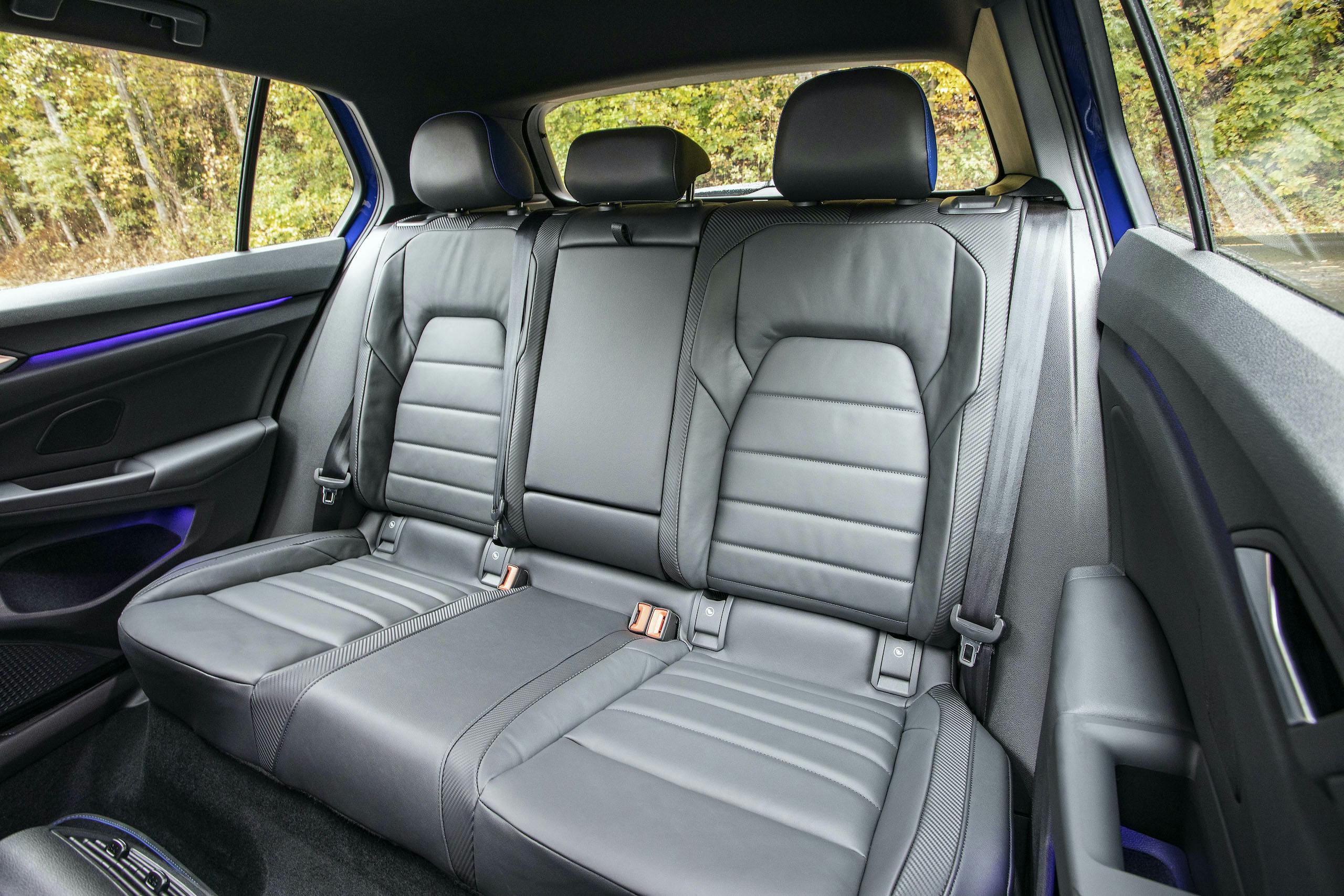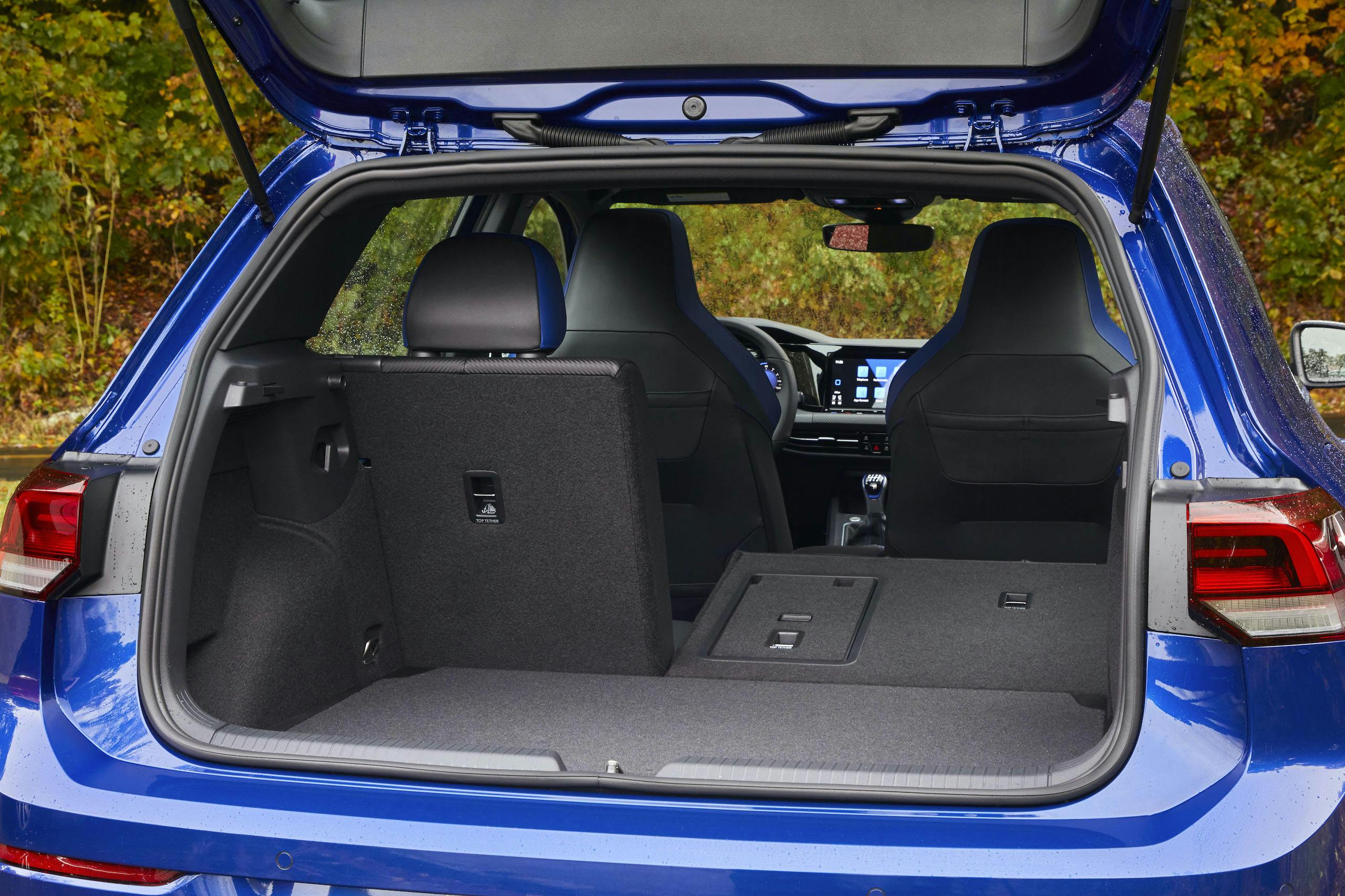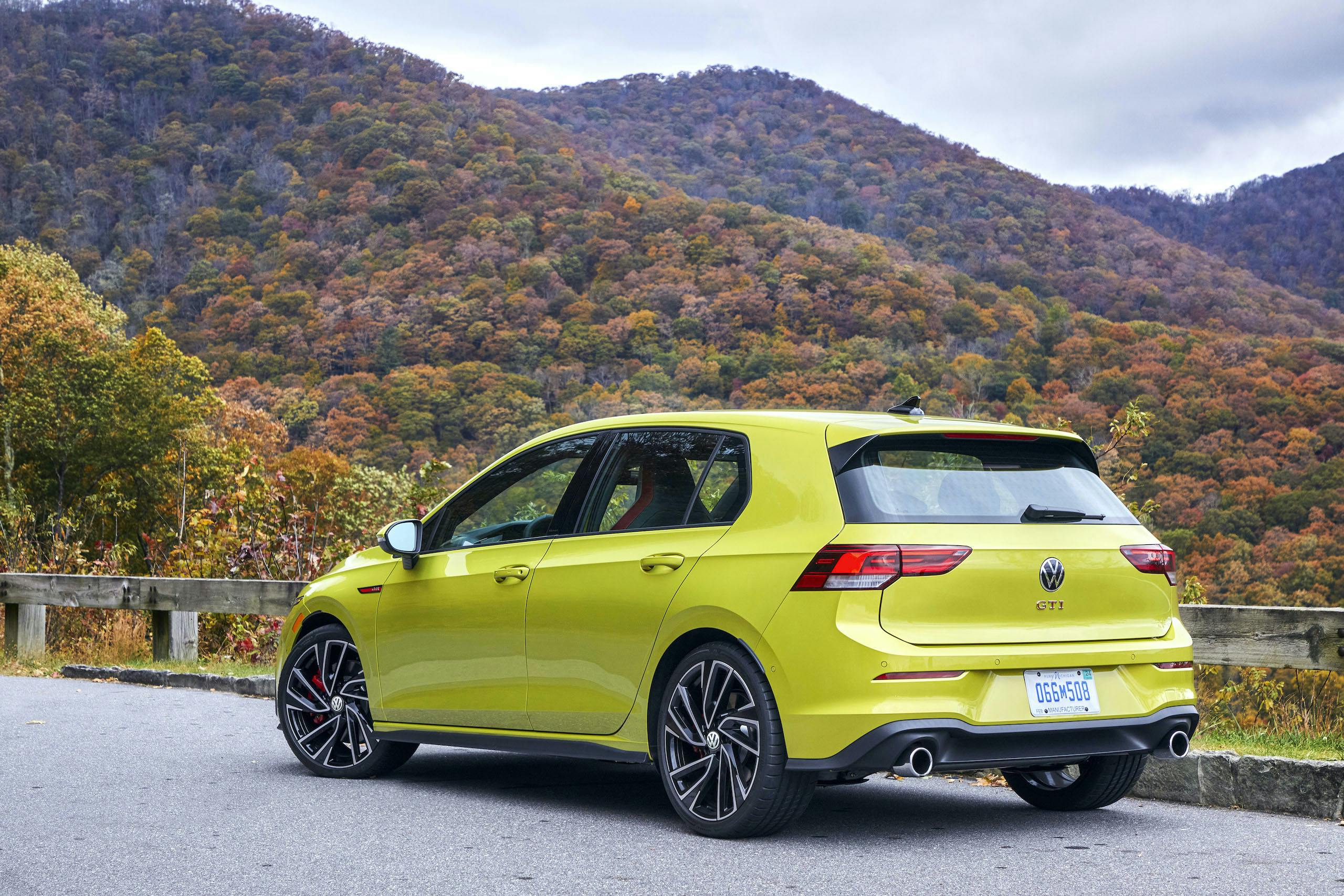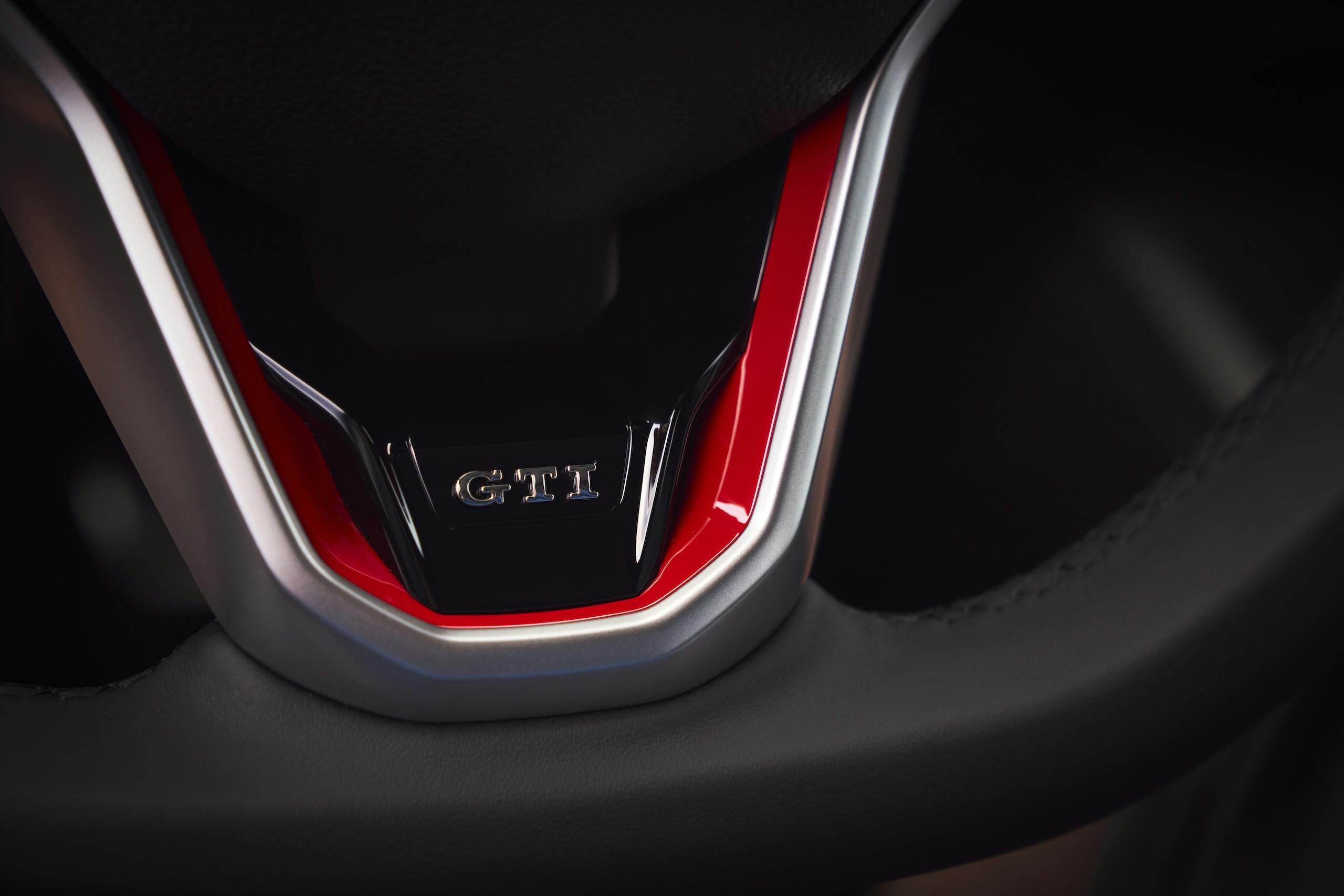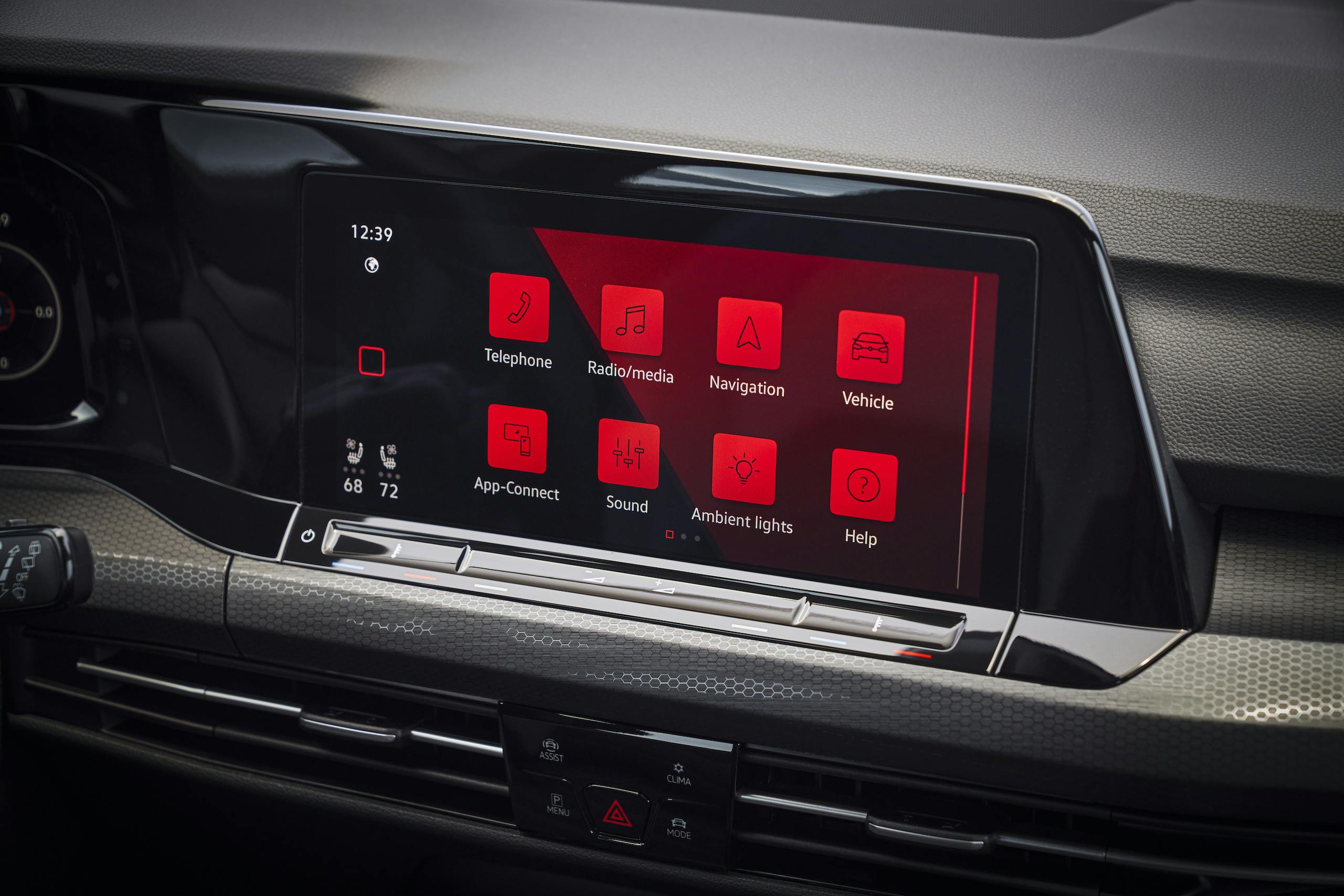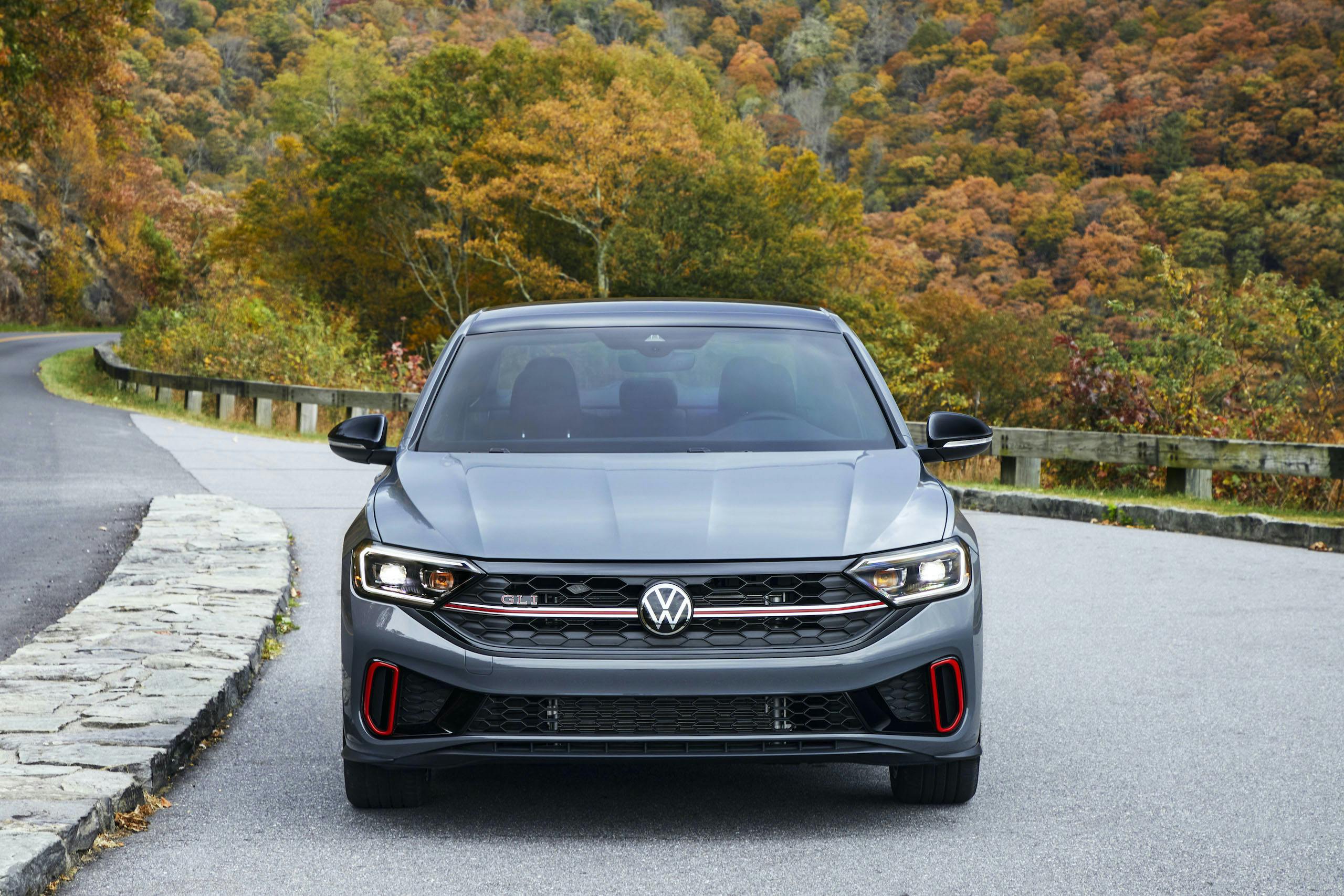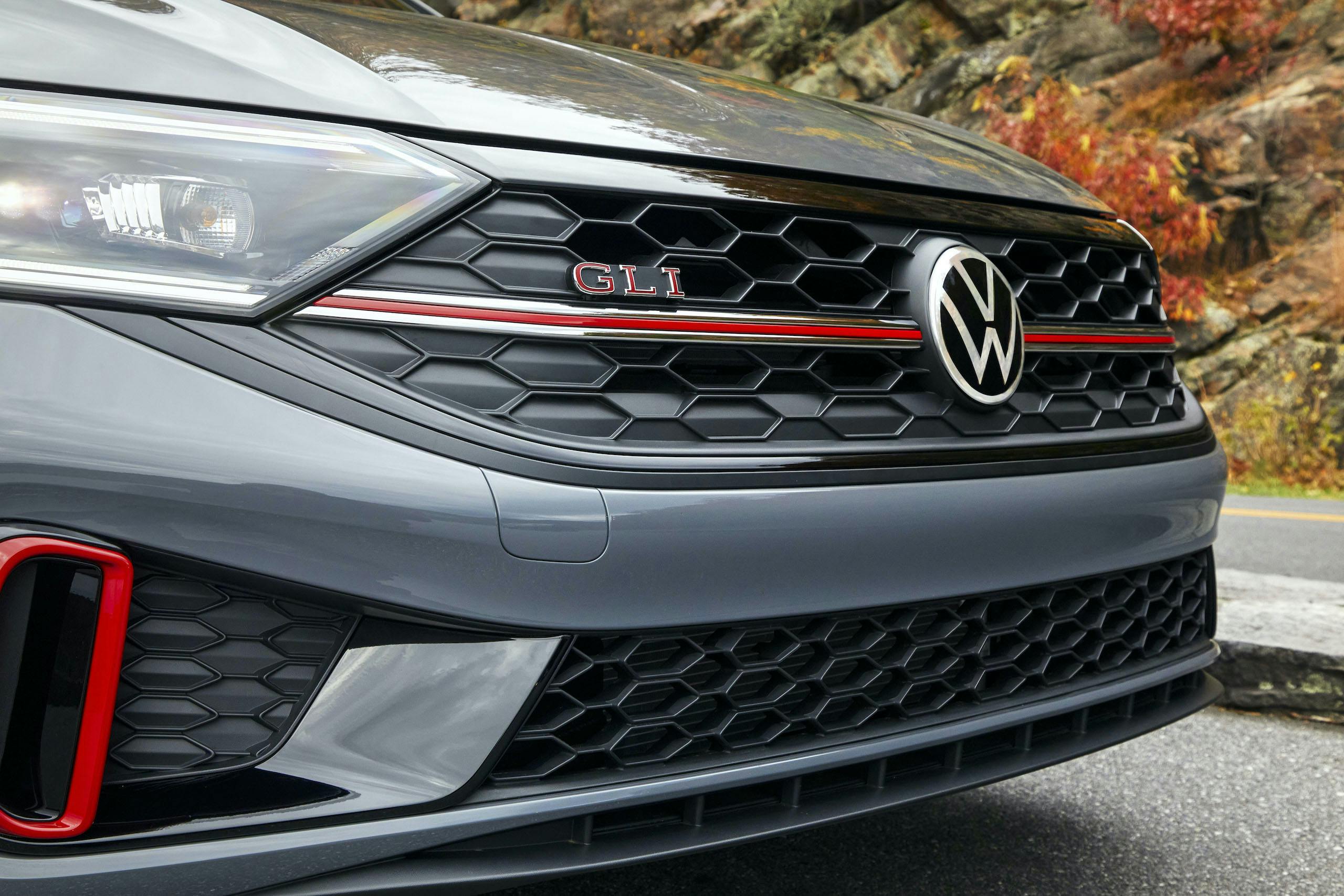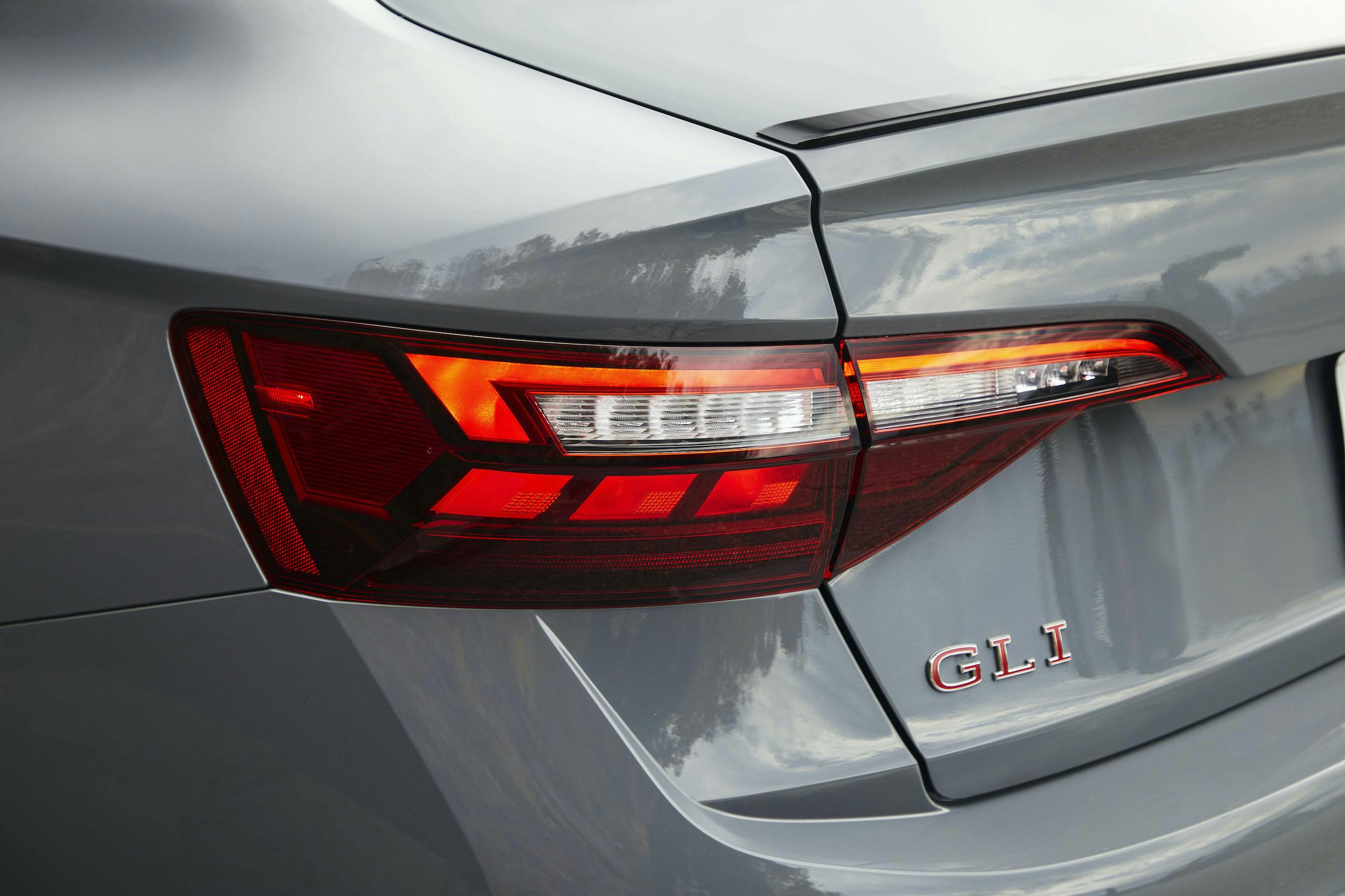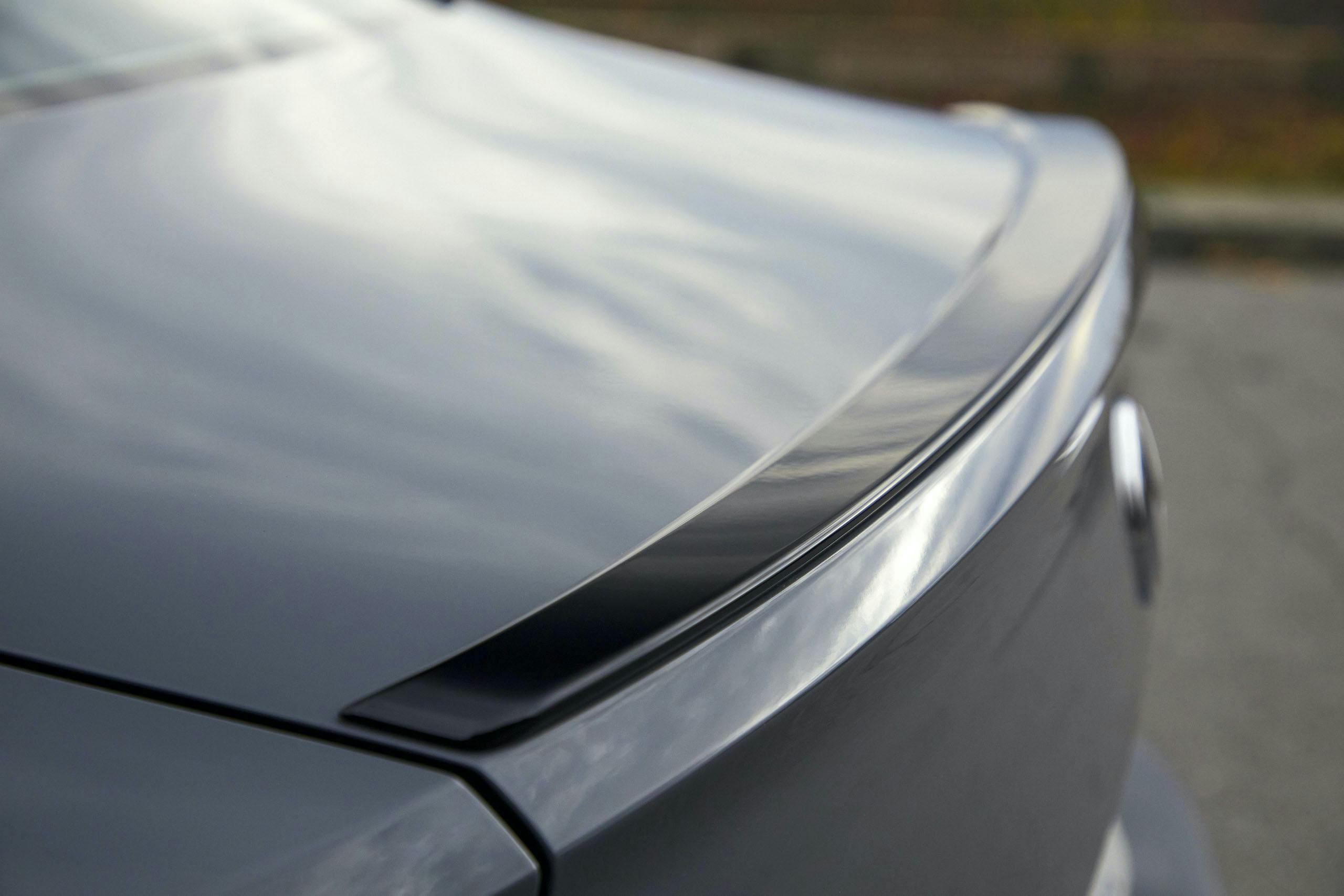First Look Review: 2022 Volkswagen Golf R, GTI, and GLI
Like most car companies, Volkswagen of America sells SUVs. A lot of SUVs. VW moves more SUVs in this country than it does ordinary passenger cars, but unlike with most car companies, this is a relatively new development. In 2016, the German manufacturer’s lineup hosted just two sport utilities; those vehicles represented only 14 percent of the company’s total sales in North America. In 2021, there are five—Taos, Tiguan, Atlas, Atlas Cross Sport, and the ID.4 electric. Those models represent 72 percent of the company’s offerings, and they virtually fly off of lots. The Atlas in particular is the country’s fifth-best-selling midsize SUV, behind a Jeep and ahead of a Kia.
“We honestly feel like we are finally getting it right, in terms of product portfolio, what the American market needs and wants,” Hein Schafer, VW’s senior vice president of product and strategy, recently said. His company is now on track to lodge 400,000 annual sales this year in this country alone. That’s a hell of a land for any manufacturer, let alone a firm that sold almost 80,000 fewer vehicles just five years ago and was not unhappy to do it.
All of that is fine, but most SUVs are not exciting. Large and heavy vehicles built of inefficiency and purpose have their place, but few people buy them and dream of fast runs down back roads.

On that note, we recently attended a VW media event in Asheville, North Carolina. In those blue and moody mountains, your author had a chance to drive every SUV Volkswagen currently makes. Being familiar with each of those, I gravitated toward the enthusiast cars: The GTI (one of the best hot hatches in the business), the Golf R (basically a faster, all-wheel-drive GTI), and the Jetta GLI (the company’s small sedan warmed up with GTI mechanicals and a few choice changes).
For better or worse, this is what this company once was, full stop. The GTI built Volkswagen as we know it today. The Golf R is the marque’s gift to diehard enthusiasts. And the GLI is the fastest available version of a name that was for decades attached to the company’s best-selling car.
Without further ado, this is what you get, when you sign up for the kind of Volkswagen that America used to love, before it fell in love with high seats and truck looks.
***
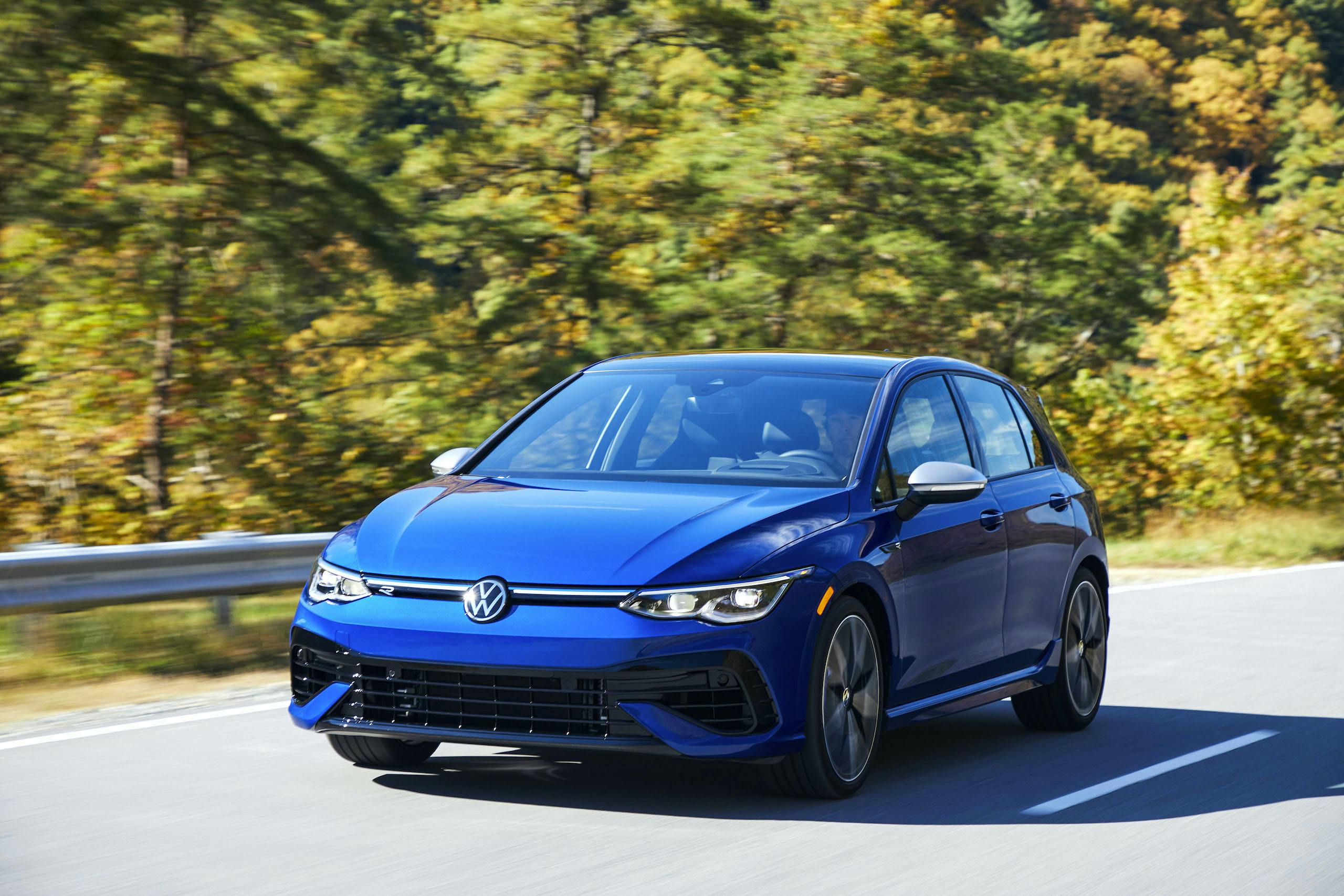
2022 Volkswagen Golf R
2.0-liter turbo I-4, 315 hp, 310 lb-ft
6-speed manual / 7-speed dual-clutch automatic
3400 lbs (est.)
MSRP: $44,640
The Basics: America has seen five R-model Golfs to date. The first, the 240-hp R32, existed in our market only in 2004, on the fourth-generation Golf platform. More than 5000 were sold here. Each wore a narrow-angle V-6 (VR, in VW-speak) paired to a six-speed manual and a Haldex all-wheel drive system. A BMW-owning friend once called that package a “four-wheel-drive BMW E36 M3,” and he meant that as high compliment. That particular person also bought an R32 new and spent the next few years fielding calls from local dealers who wanted to buy his VW back to resell, chasing demand. Volkswagen-heads loved the thing, and resale sat near sticker for years.
The 2022 Golf R is a 315-hp, turbocharged, all-wheel-drive, four-cylinder four-door. These days, that could mean anything from a small SUV to Japanese sport sedan, so just imagine a Golf GTI with two more driven wheels and more boost, because that’s exactly what it is. (The VR6 went away after the second R32, sold here from 2007–2008; the model has been named Golf R since.)
Who doesn’t love a hot Golf? More to the point, who doesn’t love a hotted-up hot Golf?
Answer: An awful lot of ordinary people who look at that window sticker.
Hell of a car, though.
Like its predecessors, the ’22 model features enough stopping grip and torque to easily double the posted limit on most public roads. In high-speed manners, it is approachable, forgiving, and low-drama; a lot of people without a V-8 or EV fetish think they want a Porsche 911 to go fast in, but what they really need is this, because it is cheaper to maintain and less of a cop magnet, and you can fold the seats down and haul things.
Sounds good, right? Here’s the catch: The Golf R is also an expensive version of a low-cost small car. VW no longer sells the base Golf in America, but dead-stock 2021 models have a base price of just under $23,000. The Golf R is essentially that car with more power and suspension, all-wheel drive, plus larger wheels and brakes. To make the package more appealing, VW’s North American arm tacks on nearly every option in the euro-Golf book—the larger of the two available navigation screens, a head-up display, unique front and rear heated sport seats, premium stereo, the list goes on. There is a track mode and a drift mode, and each affects driveline and damper behavior. In the former, the car’s interior lighting turns bright green, in homage to the Nürburgring, a.k.a. the Green Hell. The exhaust is relatively quiet, the exterior subtle.

If you find all this appealing, good for you. Golf Rs are typically sold to enthusiasts. Sales figures and customer surveys tell us that you are probably a Volkswagen person. You probably know what the words “Waterfest” and “two point slow” mean. Five dollars says you find cars like the Honda Civic Type R and the Subaru STI—machines of similar background and performance and price—too obvious and in-your-face.
The Intangible Good: It’s basically a GTI given all the grip and power you’d ever need on a real road. Styling won’t make the authorities look twice. The GTI’s exit wheelspin is gone—every corner becomes a matter of steer-and-stomp while the center differential figures things out. The brake pedal doesn’t budge or fade even on long and fast downhill mountain runs. The front tires have grip for days and the rear tires like it when you carry brake through the beginning of a corner, to set the car. Back roads are best dispatched windows-up and stereo on, low-drama. This is a quiet rule-breaker, not an obvious goon.

Fun Fact: The Golf R sees a standard manual gearbox only in the United States and Canada; the car is automatic-only in the rest of the world. One VW representative in Asheville allowed as how it was a “big fight” to make VW’s German home office sign off on an R-model clutch pedal. Like most manufacturers, Volkswagen has effectively stopped developing manual transmissions.
Why did we luck out here? One word: Sales. North America is the world’s largest GTI market, and one of the largest markets for Golf R. The GTI’s manual-gearbox take rate—the percentage of buyers who tick the box for a clutch pedal—is around 40 percent. The Golf R is closer to 50 percent. (Perspective: The Honda Civic is currently around 13 percent.)

The Drawbacks: It’s a Mark 8 Golf: The interior feels a smidge cost-cut and hollow, especially next to the outgoing Mark 7. The touch-panel dash has few buttons, with most features buried in a menu in the car’s center screen; complicating matters, those menus are unintuitive and unnecessarily complex. (Do we really need multiple swipes and taps for simple tasks like fan speed or seat-heat adjust, or turning off stability control?)
The steering is linear and weighty but doesn’t have a huge amount to say.
The engine is a bland torque-delivery device in even its most aggressive and exhaust-poppy modes. There’s a modicum of lag down low, but the rest of the tach is a flattish, anonymous torque curve. The car comes across as something of a shrinking violet, especially next that first R32 or some past Golf Rs. Imagine a small Audi minus a bit of chassis personality.

The GTI generally rides softer, with less head toss and around-town fidget. Probably not the sort of thing you care about, if you are buying a Golf R. But it might bother your grandparents.
The greatest stumbling block here is how experience doesn’t always align with price. The R is genuinely quick and satisfying to drive, but the standard GTI feels no less special and immediate when driven in isolation. It’s slower by a nontrivial amount, but it’s also ten grand less.
Summary: The poster child for the hypercompetent, hypersubtle, digitally managed fast small car, but you have to like light under a bushel. And that price.
***

2022 Volkswagen GTI
2.0-liter turbo I-4, 241 hp, 273 lb-ft
6-speed manual / 7-speed dual-clutch automatic
3150 lbs (est.)
MSRP: $30,540
The Basics: Two ways to think about this: This car is either the current base Golf plus a bit of power and suspension talent, or it’s the Golf R (above) minus power and suspension talent. Either way, America doesn’t get the base Golf any more, because it didn’t sell, so if you want a reasonably priced Volkswagen hatch, this is your only choice.
Thankfully, it’s still quite good to drive. Not perfect. Not the bright spark it once was, at least in the chassis department. A Hyundai Veloster N is still more lively and responsive and more interested in working its rear axle, and a Mark 5 GTI (2006–2009 in America) still feels like the ultimate modern evolution of the form, before the Golf got wide and became a better family car. The tradeoff, of course, is that the last few Golfs have had rear seats more comfortable for adults, and been quieter and generally more composed than their predecessors.
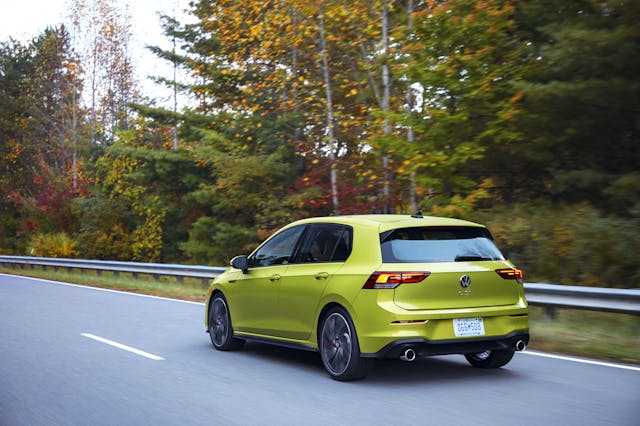
The Intangible Good: We’ve reviewed this car before, albeit only on a track, at a Volkswagen media event without public-road access. The good bits remain: Cars of this nature are thin on the ground, and this is still a remarkably well-rounded example. Few new cars will carry as much effortless pace over a winding road, for as little cost, and still feel fun around town. Corners are dispatched without effort or passenger abuse, and without much ask of brains or stress from the driver; you just hustle. Cockpit visibility is great. The EPA says highway fuel consumption should land around 34 mpg, but if it’s anything like the Mark 7, real-world numbers will be closer to 40.
The differential and front axle are noticeably sharper than in the last GTI. The diff in particular reacts more quickly in the midcorner, helping to mitigate entry and throttle understeer and help the car go where the wheel is pointed.
Fun Fact: As of the Mark 8, American-market GTIs are built in Germany. The Mark 7 was built in VW’s plant in Puebla, Mexico. This probably means little as far as quality or fit and finish, but it’s always nice when objects of deep cultural import come from the place where their culture was born.
The Drawbacks: Interior. (See Golf R, above.) Also that interior. Have we discussed the interior? The more time you spend in it, the more frustrating it gets. The Mark 7 offered a lovely little cockpit with simple controls that could be adjusted without taking your eyes off the road. This isn’t that.
Volkswagen PR people will tell you that you are being a little drastic if you don’t like how the inside of this car works, or find it difficult. To that, I say, try driving up a North Carolina mountain with the windows open on a chilly day and attempting to increase the heater fan speed—not the temperature, just the speed—without taking your eyes off the road. You will eventually yell something unpleasant at one of a series of menus. Or the touch buttons beneath the large central screen, which can be hard to differentiate if you’re not looking right at them.

Like the Mark 7 GTI, this car could probably make do with a little less power; it’s not fast by modern standards, merely quick enough, and corner exits often involve a bit of unsatisfying wheelspin. Hot hatches work best when they seem to have more grip than power—you spend more time on the throttle and less worrying about why the differential keeps trying to blow the front tires to pieces. Stepping out of the Golf R and into this, you don’t miss the sheer speed so much as the flexibility—the R’s midrange is simply broader and more stout.
The steering is slightly less interesting than in the Golf R. Less weight. Communication and messages sent through the rim are similar. Brake feel is noticeably less reassuring than in the Golf R. The pedal is consistent, just longer and softer.
Summary: A GTI. Maybe a bit less satisfying than the last one, but faster and just as much an all-rounder for daily life. Which means you can still use it to go chase your friend’s 911 in the hills and feel like you made a responsible purchase.
***
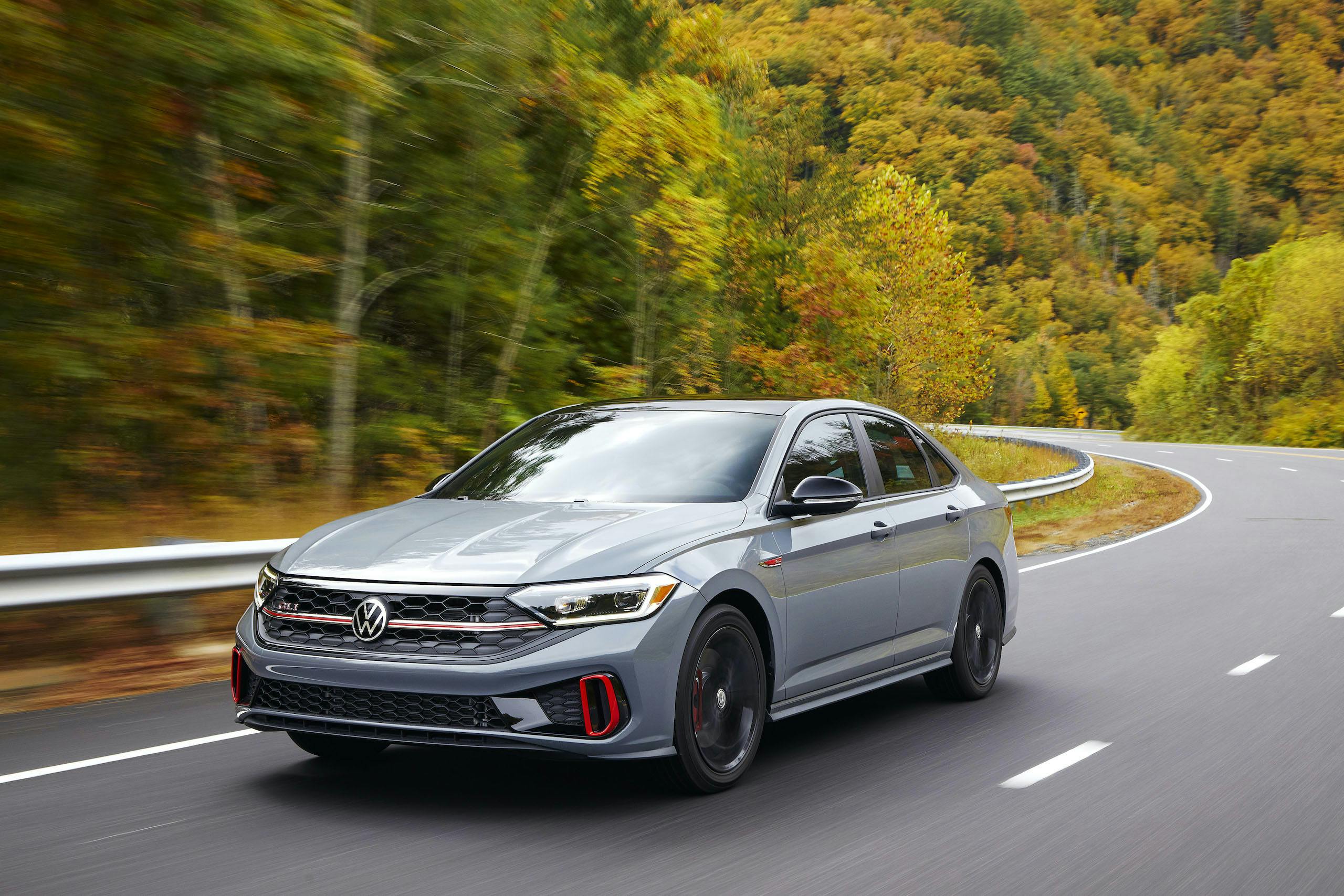
2022 Volkswagen Jetta GLI
2.0-liter turbo I-4, 228 hp, 258 lb-ft
6-speed manual / 7-speed dual-clutch automatic
3250 lbs (est.)
MSRP: $31,990
The Basics: It is “still an important part of our lineup,” they say. “This segment is all about value.” And other nothingburger statements, because when you are at an event for a carmaker’s full line, and most of those cars are relatively new, you don’t want to make a big deal about the old thing that hasn’t been replaced yet. But … the old thing isn’t being replaced yet.
Not that it’s old—the current Jetta was launched in 2018, and the current GLI only dates to 2019. It’s more that the car feels old, in the current moment, next to the competition, which is generally less visually fussy. A journalist listening to that presentation thinks about the Jetta’s mostly Asian competitive set, and mulls the long-term repair costs of the average Volkswagen. The 2022 Jetta marks the model’s midcycle refresh—a cosmetic face-lift and light technical update. There are presentations and Powerpoint decks! No one specifically mentions the car’s life cycle, but they also don’t toss around the phrase “all-new,” which is what manufacturers use any time a car is all-new, or even only slightly new. Sometimes they use that phrase for cupholders.

Another journalist points out, under their breath, how the new red accents on the GLI’s front-bumper brake ducts resemble clown lipstick. (New!) The base Jetta, 70 hp weaker than the GLI, gets LED headlights for this year and a standard 8-inch digital instrument cluster, plus a new 1.5-liter and 11 additional horsepower. With the GLI, there are no really changes save a $250 bump in price and new bumper covers. The exhaust has been reworked to sound more chesty and baritone.
Forty-two years ago, the Jetta began life as little more than a Golf with a trunk. The model evolved to spend decades as a strong seller and an emotional bright spot in VW’s American lineup. The GLI, around for nearly 40 years, has long been a cross between Jetta and GTI, the four-door sedan with driveline and suspension bits or philosophy borrowed from the hot hatch.
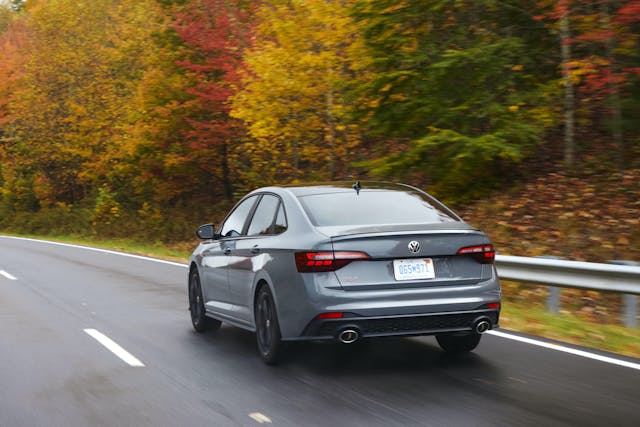
The air in the room carries the distinct vibe of everyone wanting to talk about literally anything else, even if they are getting paid to talk about this car. And then you find yourself on a manufacturer drive event in the North Carolina mountains with a goofy-looking front-drive sedan with three pedals and the engine from a GTI. Wondering why a GTI isn’t as much fun to huck through a corner, even if that car is far and away faster.
A nonhybrid, non-EV, four-door sport sedan with an available manual transmission may not seem wholly fashionable right now, or that interesting. That doesn’t mean you shouldn’t be interested.
The Intangible Good: One of the few midsize cars still available with a clutch pedal, and probably the only one with a chance of being stocked by your dealer. The chassis is delightful, playful and happy in corners despite its bulk. Power comes from a 228-hp, 285 lb-ft version of VW’s EA888 turbo four.
That engine’s exhaust note is somehow more raucous and entertainingly rough here than in any other Volkswagen product. Lag is minimal and mostly present during big throttle change at low rpm. There’s also real steering feel, with kickback and transparency. The shifter is a ropey cable setup, traditional VW plus relatively long throws, but fun to knock through. (Not the greatest thing in the world, but in this day and age, we’ll take it.)
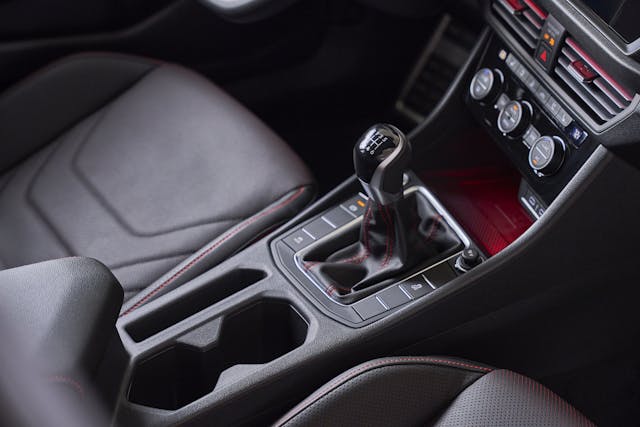
A 2019 GTI sits in my driveway. My wife and I bought it new for road trips and family hauling. The car has been satisfying and thrifty for nearly 30,000 miles, to say nothing of dependable and fun. There’s no accounting for taste, but if the GLI’s looks hadn’t rubbed me the wrong way, we would have bought one of these instead. The Mark 7 and Mark 8 Golfs feel like modern Volkswagens. The GLI feels like a modern Volkswagen blended with one from 20 years ago. The sum is more than the collected parts.
Balance is everything in a car like this, speed less important. The GTI and Golf R are easier and more composed at any pace. They bottom out less over heaving asphalt, and they don’t need as much spring rate to make even greater grip. They ride more comfortably. But there’s something surprising here, a remarkable degree of feedback and the fun that comes from managing balanced weight. Especially when you consider the relatively staid alternatives—a Camry, say, or an Accord.

Fun Fact: The GLI uses a multilink rear suspension. Buy an ordinary Jetta, you get cheaper but less effective beam axle. Most people will not care or notice, but on a back road, side by side, you can tell. Ride quality and handling are noticeably different with the beam, and not for better. This arrangement has existed for years, one of the ways that VW makes the base Jetta affordable.
Fun fact number two: According to Volkswagen, 50 percent of GLI buyers opt for a clutch pedal. Clutch pedals are fun. Good job, America.
The Drawbacks: Only available in one trim, Autobahn. Last year, you could choose from two trims. (That said, Golf R brakes and adaptive dampers are now standard on the GLI. So is VW’s excellent VAQ limited-slip differential. You want all that stuff.) The cabin feels dated and low-cost flashy, with shiny plastics and finish quality that still seems a tick behind the Japanese, designed to look good in a showroom but not age well.

The stock tires aren’t quite as sporting as the rest of the car and give up early when you don’t expect it. Much of the GLI’s handling prowess seems to have come at the cost of suspension travel; undulating back roads get you thinking about bump stops, then googling aftermarket shocks.
Summary: A satisfying and simple sport sedan that won’t run away from a GTI or a GLI down a back road. If you’re not chasing one, you won’t care, because you’ll be having too much fun. Not a wholly new car, and far from perfect, but feels like sporting VWs used to. If you know what that means, you know.

